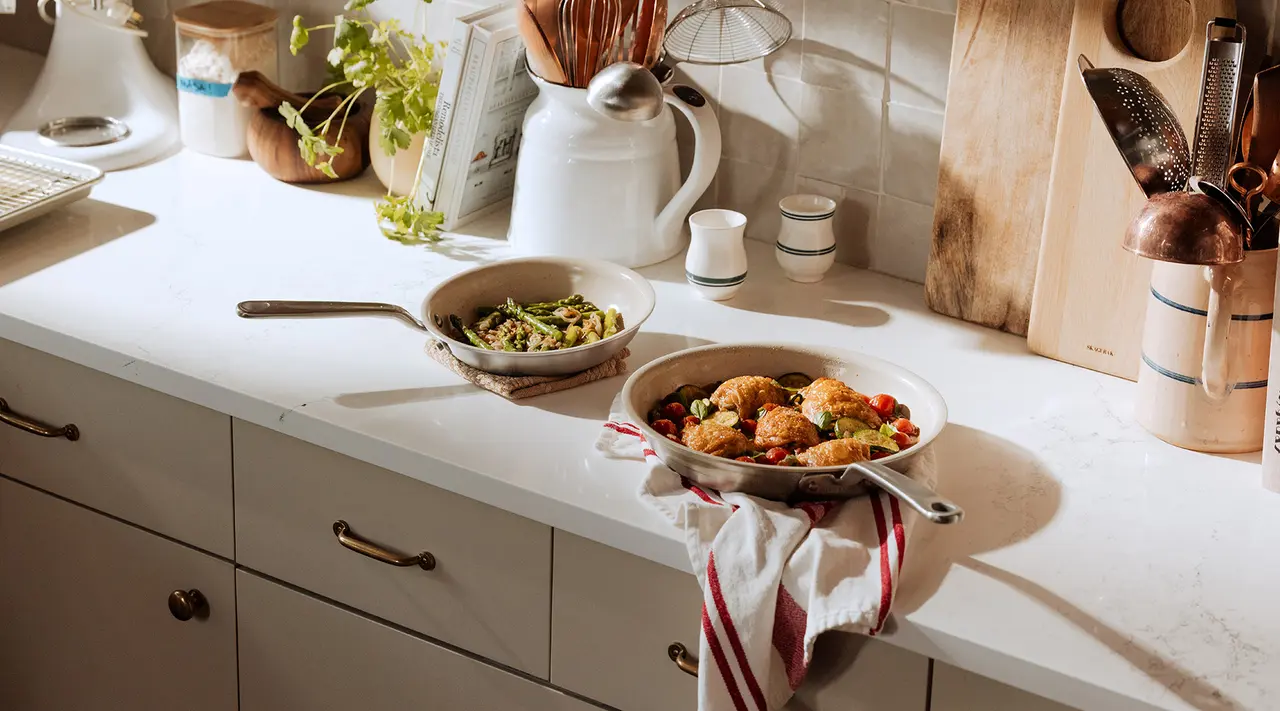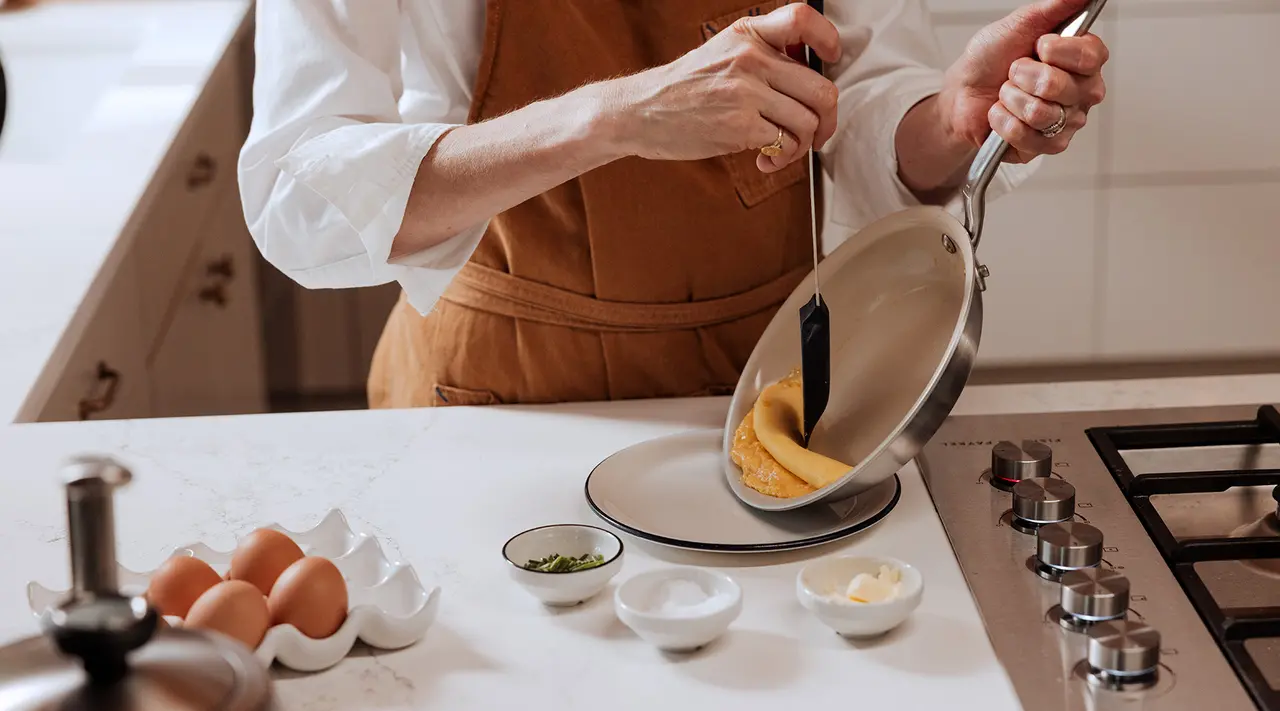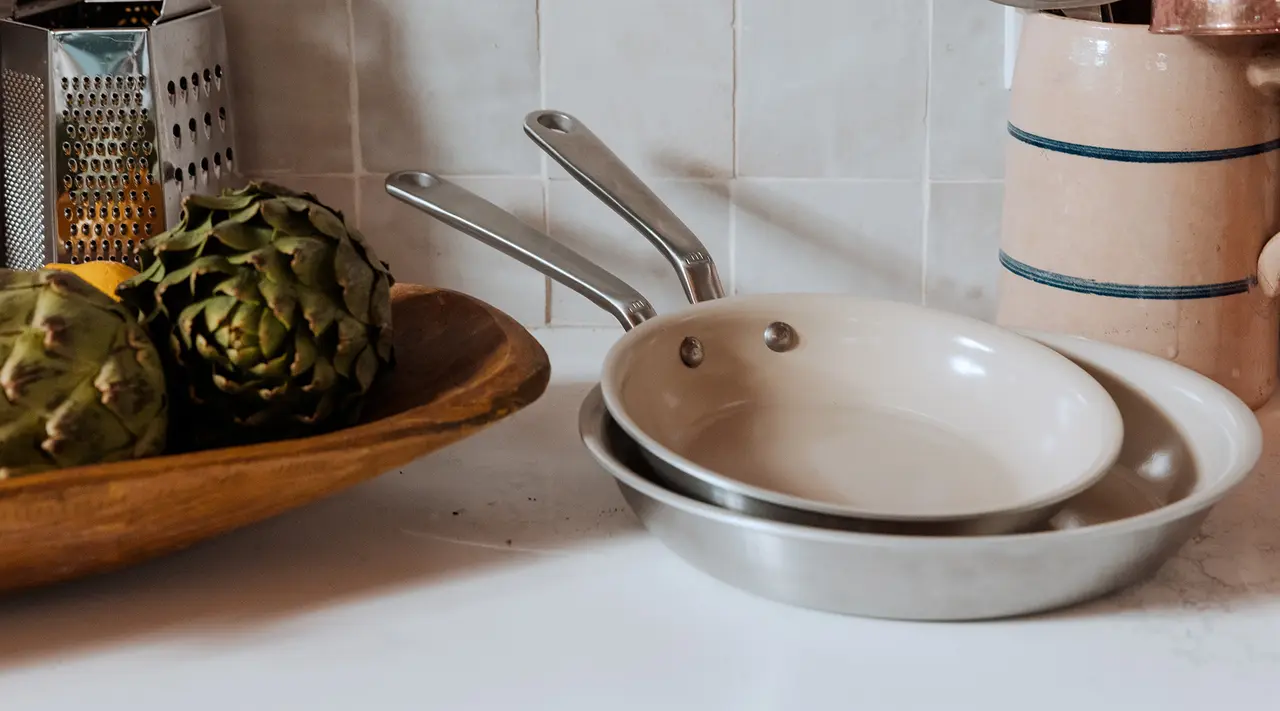With our foray into ceramic cookware by way of our new CeramiClad™ Collection, we’re just as eager as you to understand how they compare with other popular cookware options on the market.
Today, we’re putting ceramic head-to-head with aluminum cookware. This lightweight, affordable, and highly conductive metal is commonly used on its own, as a component in stainless clad and non stick cookware, or as the outermost layer in ceramic pans. Yet despite the benefits of aluminum, we don’t consider pure aluminum cookware a viable alternative to ceramic. Here’s why.
Overview of Ceramic Cookware

Ceramic cookware is made by topping a metallic base—often a combination of stainless steel and aluminum—with layers of a non toxic, naturally derived "ceramic" coating. Since there are no chemicals found in ceramic, it’s often touted as a more eco-friendly and transparent alternative to traditional coated non stick.
Like conventional non stick, ceramic cookware bases are typically made from stainless steel, aluminum, or some combination of the two. Our CeramiClad™ features our 5-Ply Stainless Clad construction, resulting in evenly seared proteins, tender scrambled eggs, and perfect pancakes.
Key Benefits of Ceramic Cookware
Whereas cheaper pans (i.e. those not made from a Stainless Clad base) might distribute heat unevenly, leaving you with hot and cold spots, high-quality ceramic cookware sears just as effectively as your favorite non stick pan. Plus, ceramic is just as nice to look at as it is to cook with, and often comes in display-worthy colors and designs.
Overview of Aluminum Cookware
Lightweight, affordable, and highly conductive, aluminum is commonly used as one of the cladding layers in stainless clad cookware or as the base for non stick cookware. You’ll find both plain aluminum cookware and hard-anodized aluminum, the latter of which tends to be more durable and scratch-resistant (though also more expensive).
Limitations of Aluminum Cookware
One of the reasons cookware brands use aluminum as a cladding material, rather than on its own, is the fact that it’s not especially durable when compared to other metals. Aluminum is relatively thin, making it much more prone to warping, denting, and corrosion than stainless steel, for example (unless we’re talking about hard-anodized aluminum). It’s also a reactive material, meaning that it shouldn’t be used for cooking with acids like wine, citrus, tomatoes, or vinegar.
Ceramic vs. Aluminum Cookware: Head-to-Head Comparison

From safety to performance, here’s what you can actually expect from these two different cookware materials.
Health and Safety
Again, ceramic is frequently touted as an alternative to conventional non stick cookware due to its naturally derived coating. Aluminum is also synthetic coating-free, and is generally quite safe to cook with. While there have been some concerns, historically, about aluminum leaching into food, the amount of aluminum that leaches into food from cookware is extremely minimal.
Cooking Performance
In terms of actual cooking performance, ceramic beats aluminum, hands down. While aluminum is known as a fast conductor of heat, fully cladded ceramic cookware heats more evenly and retains that heat better than aluminum, which also runs the risk of warping over high heat. It’s also induction-compatible, unlike pure aluminum.
Durability and Longevity
Ceramic cookware made with a cladded stainless base is considerably more durable than aluminum cookware. As we touched on, non-anodized aluminum is thin and fairly malleable, making it easy to dent, scratch, and warp. While, like all coated cookware, ceramic can be prone to chipping and scratching, it’s easy to clean and will last for years with proper care.
Maintenance and Care
Since pure aluminum is not non stick, it’s more prone to sticking, burning, and staining than ceramic. While ceramic requires hand-washing—we recommend hand washing over the dishwasher for most cookware—it’s still much easier to clean than aluminum cookware.
Why Ceramic Cookware Is the Superior Choice

For our money, ceramic cookware is the more well-rounded of these two options, offering superior performance, durability, and overall user experience.
Best for Health-Conscious Cooking
Ceramic cookware is an excellent option for health-conscious cooks: not only is the coating non toxic, but it also eliminates the need for excess butter and oil. While hard-anodized aluminum can be relatively non stick, non-anodized aluminum does not offer any non stick properties.
Easy Maneuverability
In addition to their non stick surface, ceramic pots and pans are also lightweight and maneuverable, making them easy to cook with, clean, and store. Aluminum is also lightweight, but usually at the expense of durability.
Versatility and Performance
When it comes to performance, ceramic easily wins out over aluminum. As we spoke about earlier, pure aluminum cookware is a relatively inefficient conductor of heat, and is rarely as durable as cookware made from cast iron or stainless clad. On the other hand, high quality ceramic cookware performs just as well as cladded non stick, and is even more versatile, allowing you to cook fish, eggs, and other sticky, high-protein foods without the mess.
Ready to Shop?
While a cheap aluminum pan might serve as a temporary solution to an empty kitchen, it won’t last nearly as long—nor perform at the same level—as a high-quality, cladded ceramic pan. Made using our 5-Ply Stainless Clad base, our CeramiClad™ Collection delivers restaurant-quality results and convenience.































